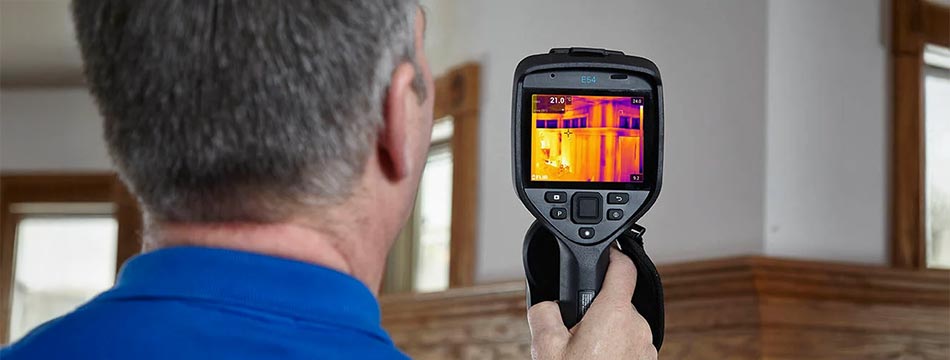
Thermal imaging cameras are invaluable tools for professionals in the construction/building industries. Construction companies, architects, councils, surveyors, landlords, retrofitting businesses, maintenance teams, and energy efficiency companies/charities can all leverage thermal imaging technology to gain critical insights into the thermal performance of buildings. This guide will explore the benefits and applications of thermal imaging in construction and will recommend the best thermal cameras for building inspections.
Browse building & surveying thermal cameras:
Internal Use External UseQuick Links
- Advantages of Using a Thermal Imaging Camera for Construction
- Applications of Thermal Cameras in Construction
- Benefits of Using a Thermal Imaging Camera for Construction Applications
- Best Thermal Cameras for Building Inspection & Construction Applications
- Choosing a Thermal Imaging Camera for Construction: Technical Specifications & Recommendations
- Conclusion: What is the Best Thermal Camera for Building Inspections?
Advantages of Using a Thermal Imaging Camera for Construction
Why Use a Thermal Imaging Camera for Building Inspection?
Thermal imaging cameras offer numerous benefits for building and construction professionals:
- Enhanced Diagnostics: Quickly identify issues such as heat loss, poor insulation, water leaks, and thermal bridges.
- Preventative Maintenance: Detect potential problems early to prevent costly repairs and damage.
- Energy Efficiency: Improve energy efficiency by identifying areas of heat loss and poor insulation, ultimately reducing energy consumption and costs.
- Quality Assurance: Verify the correct installation of building materials and systems, including solar panels.
- Safety: Identify HVAC faults and overheating components to prevent hazards.
Applications of Thermal Cameras in Construction
Where & When to Use a Thermal Imaging Camera for Building Inspection
Thermal imaging cameras can be used at different stages of building projects and post-construction to assess the thermal performance of properties as well as identify potential issues in their infancy.
Energy Efficiency
Thermal cameras are ideal for assessing insulation, detecting thermal bridges, and locating areas of heat loss. This makes them perfect for retrofitting projects evaluating and improving the energy efficiency of existing buildings.
Moreover, IR cameras can be used to verify the functionality of solar panels, enabling surveyors, landlords, homeowners, etc, to check roofs for heat loss and monitor the health of solar panels.
To learn more about how thermal imaging cameras can help you maximise energy efficiency and therefore lower your energy bills, please see the following articles:
- How Do Thermal Cameras Help You Save On Your Energy Bills?
- FLIR’s Top Tips for Ensuring Energy Efficiency
Building Maintenance
Implementing thermal imaging as part of routine maintenance or inspection procedures makes identifying issues such as water leaks, poor insulation, and areas susceptible to mould quick and easy. It also means these faults are more likely to be caught earlier, making correction cheaper.
In addition to monitoring buildings for structural defects, thermal imaging cameras can spot problems with HVAC systems and electrical panels. As a result, infrared imaging cameras are ideal for both routine maintenance and assessing the extent of structural damage after an incident/disaster.
Consequently, plumbers and heating engineers, as well as construction companies, landlords, and homeowners, can benefit from the cost- and time-saving implications of thermal imaging. To learn more about this, please read our article Five Reasons Plumbers and Heating Engineers Need a Thermal Camera.
Construction
Builders/construction professionals can use thermal cameras to ensure materials are correctly installed and identify issues early.
Benefits of Using a Thermal Imaging Camera for Construction
In addition to improving the ease and efficiency of identifying construction issues, thermal imaging cameras offer a range of benefits to a variety of stakeholders:
- Homeowners: Improve home energy efficiency and identify potential issues; more information on how to do this can be found in our blog: Winter Is Coming: Prepare Your Home for the Long Night(s) Using FLIR Thermal Cameras.
- Landlords: Maintain property value and ensure tenant safety.
- Construction Companies: Ensure quality and energy efficiency in new builds.
- Retrofitting Companies: Enhance the energy efficiency of existing properties; discover how Leeds is using thermal imaging to target retrofitting funding: Leeds Leads the Way in Retrofitting with Thermal Flight
- Councils and Charities: Promote energy efficiency and safety in public buildings and low-income housing. Thermal imaging is already playing a critical role in council- and charity-led energy-efficiency initiatives, as detailed in the following reports:
- Maintenance Teams: Quickly identify and resolve building issues.
- Energy Efficiency Companies: Provide detailed assessments and recommendations for energy-saving improvements. Discover the ways green energy suppliers can benefit from using thermal imaging and how one utility company is already leveraging the power of thermal cameras to help its customers and the planet:
Best Thermal Cameras for Building Inspection & Construction Applications
Here are some recommended thermal cameras for various building inspection and construction applications:
Basic Cameras for Indoor Use
1. FLIR One Edge Pro
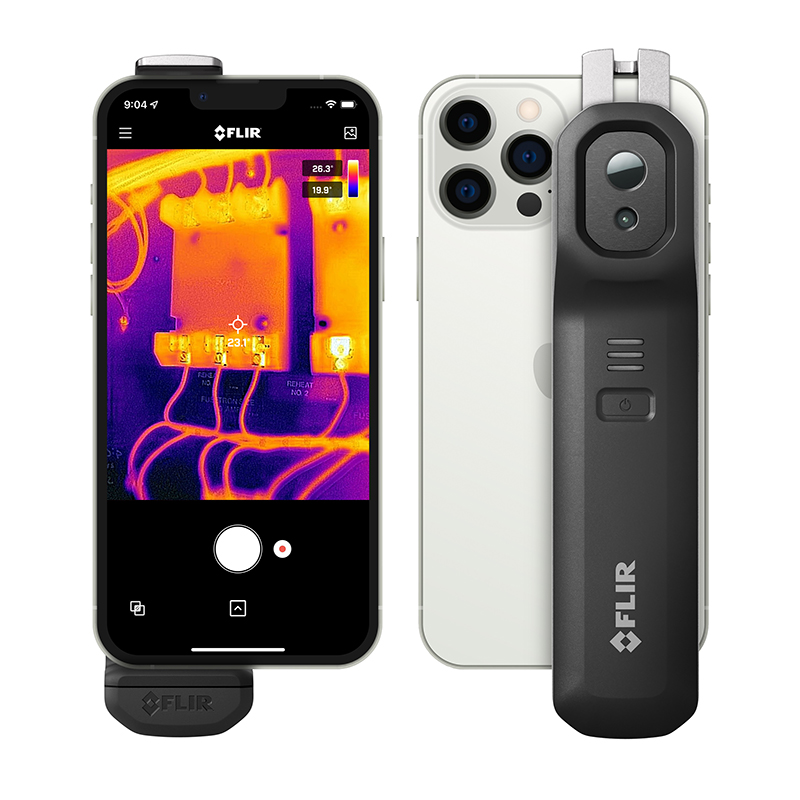
- Resolution: 160x120 pixels
- Usage: Mobile device (iOS/Android)
- Features: Basic camera with basic reporting, ideal for indoor use only.
- Applications: Locating heat loss, finding water leaks, and assessing insulation.
2. FLIR C5
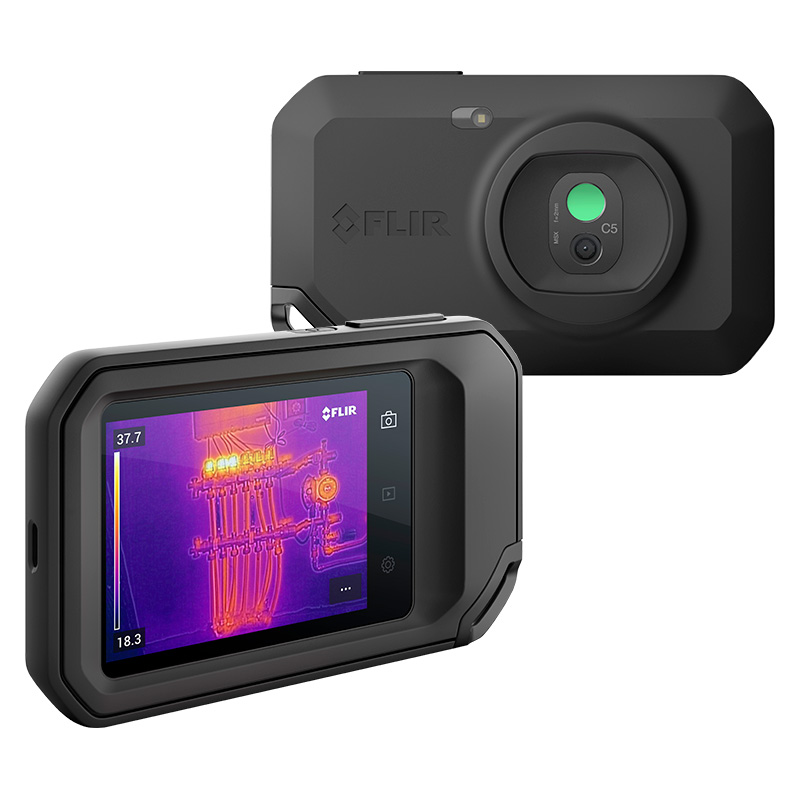
- Resolution: 160x120 pixels
- Lens: Fixed
- Features: Basic camera with basic reporting, suitable for indoor use.
- Applications: Locating heat loss, identifying poor insulation, and finding thermal bridges.
3. Fluke PTi120
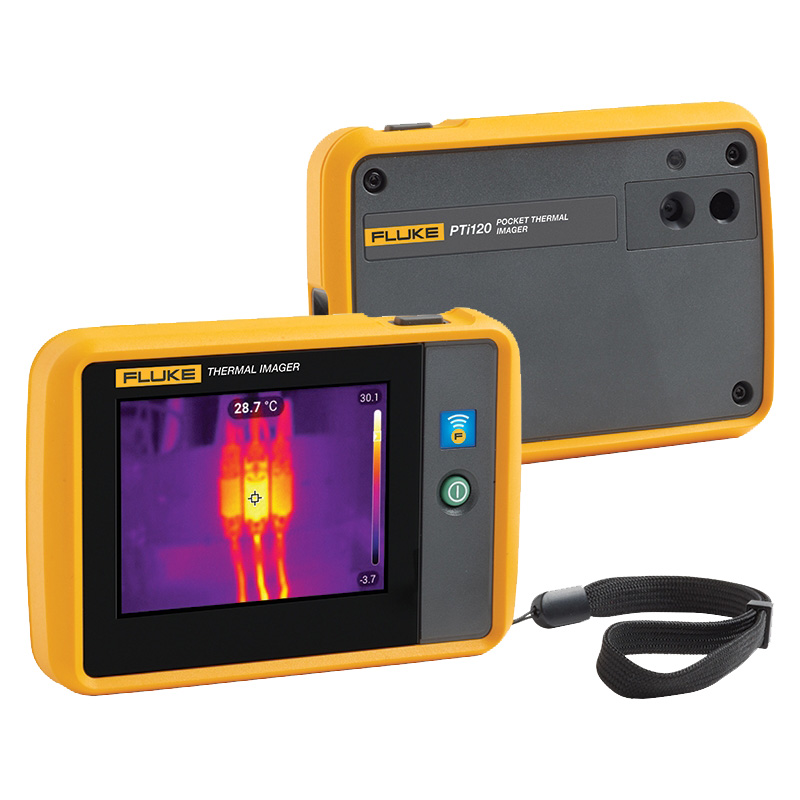
- Resolution: 120x90 pixels
- Lens: Fixed
- Features: Basic camera with basic reporting, designed for indoor use.
- Applications: Energy efficiency assessments, finding water leaks, and identifying thermal bridges.
Mid-Range Cameras for Indoor/Outdoor Use
1. FLIR E54
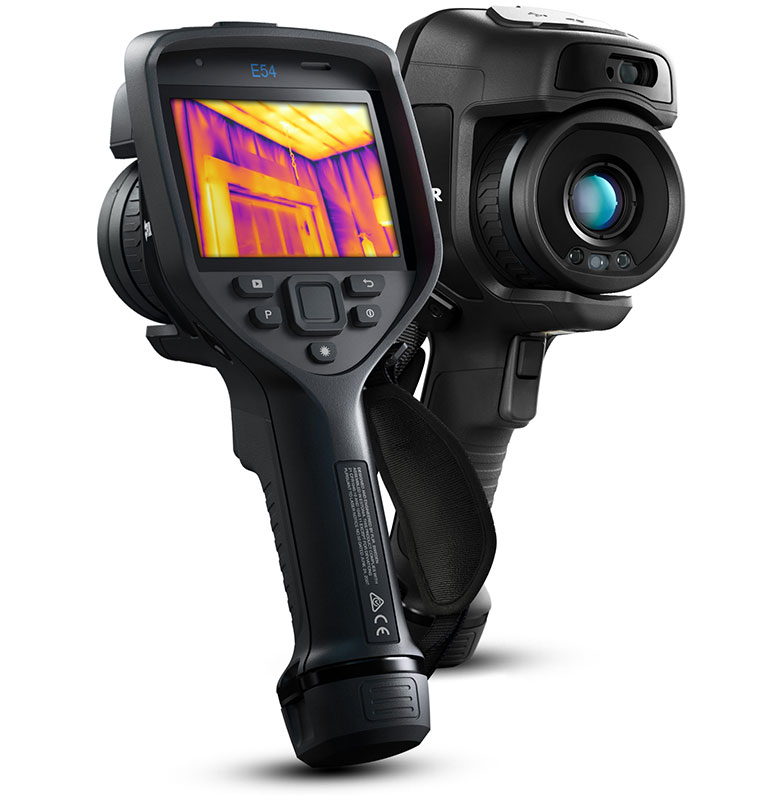
- Resolution: 320x240 pixels
- Field of View: 24 degrees
- Features: Mid-range camera with reporting capabilities, suitable for both indoor and outdoor use.
- Applications: Comprehensive building inspections, energy efficiency assessments, and identifying building defects.
2. Fluke TiS60+

- Resolution: 320x240 pixels
- Field of View: 24 degrees
- Features: Mid-range camera with reporting capabilities, ideal for both indoor and outdoor use.
- Applications: Building inspections, energy efficiency evaluations, and locating areas susceptible to mould.
Professional Cameras for Comprehensive Reporting
1. FLIR E96
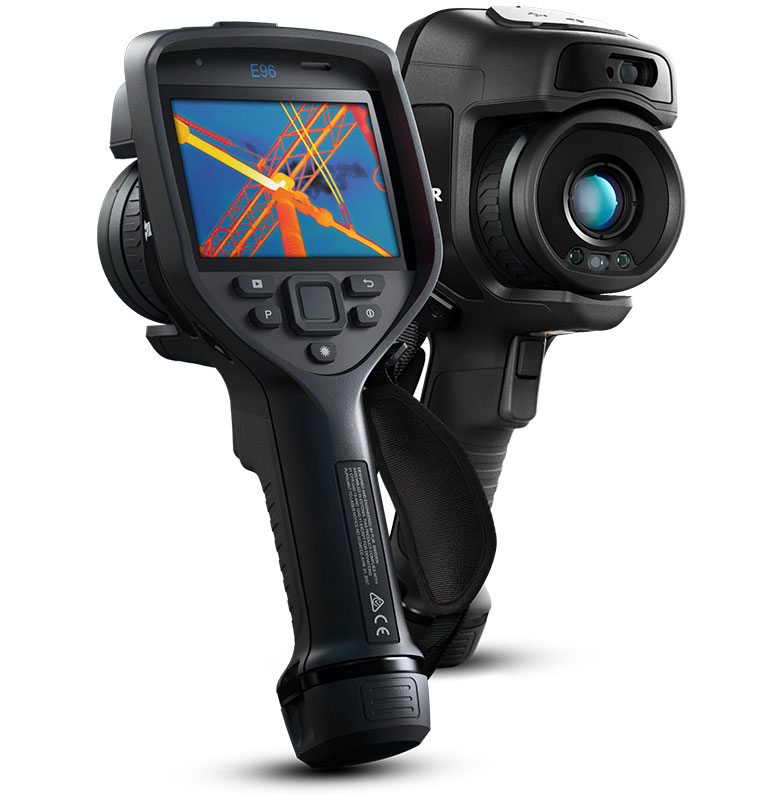
- Resolution: 640x480 pixels
- Lenses: Interchangeable (14, 24, 42, 80 degrees)
- Features: Professional camera with advanced reporting, suitable for indoor and outdoor use.
- Applications: Detailed energy efficiency assessments, verifying solar panel functionality, and finding building defects.
2. Fluke TiX501
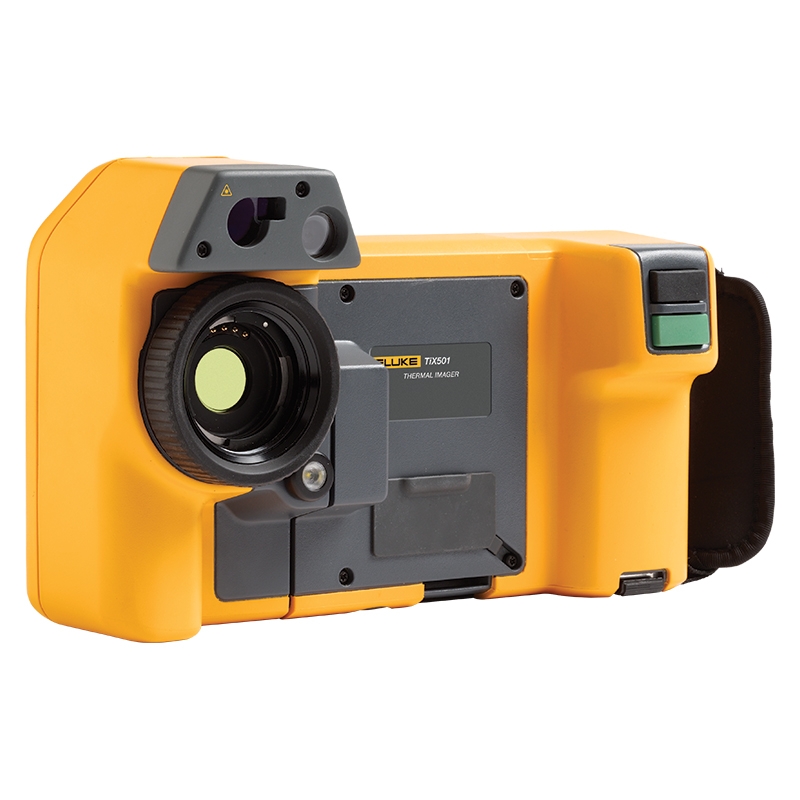
- Resolution: 640x480 pixels
- Lenses: Interchangeable (2x tele, 4x tele)
- Features: Professional camera with advanced reporting, ideal for comprehensive building inspections.
- Applications: Locating heat loss, assessing insulation quality, and identifying thermal bridges.
Choosing a Thermal Imaging Camera for Construction: Technical Specifications & Recommendations
When selecting the best thermal imaging camera for building inspection, consider the following specifications:
- IR Resolution: Higher resolutions provide more detailed images, essential for identifying small defects and conducting thorough inspections.
- Thermal Sensitivity (NETD): Lower NETD values indicate higher sensitivity, allowing the camera to detect smaller temperature differences.
- Lenses: Interchangeable lenses offer flexibility for different inspection tasks, such as wide-angle views for general surveys and telephoto lenses for detailed analysis.
- Temperature Range: Ensure the camera covers the necessary temperature range for your specific applications.
- Reporting Capabilities: Advanced reporting features help document findings and share results with clients or stakeholders.
Uncover more tips on choosing and using the best thermal imaging camera for building inspection here: FLIR’s Tips to Avoid the Top Three Home Inspection Mistakes.
Conclusion: What is the Best Thermal Camera for Building Inspections?
Thermal imaging cameras are invaluable tools for enhancing diagnostics, ensuring quality, and improving energy efficiency. When choosing the best thermal imaging camera for building inspection, consider the specific requirements of your applications and select a model accordingly. Whether you are a builder, surveyor, landlord, or energy efficiency company, investing in a suitable thermal camera will make identifying and resolving issues quicker, easier, and less expensive.
Browse building & surveying thermal cameras:
Internal Use External Use

